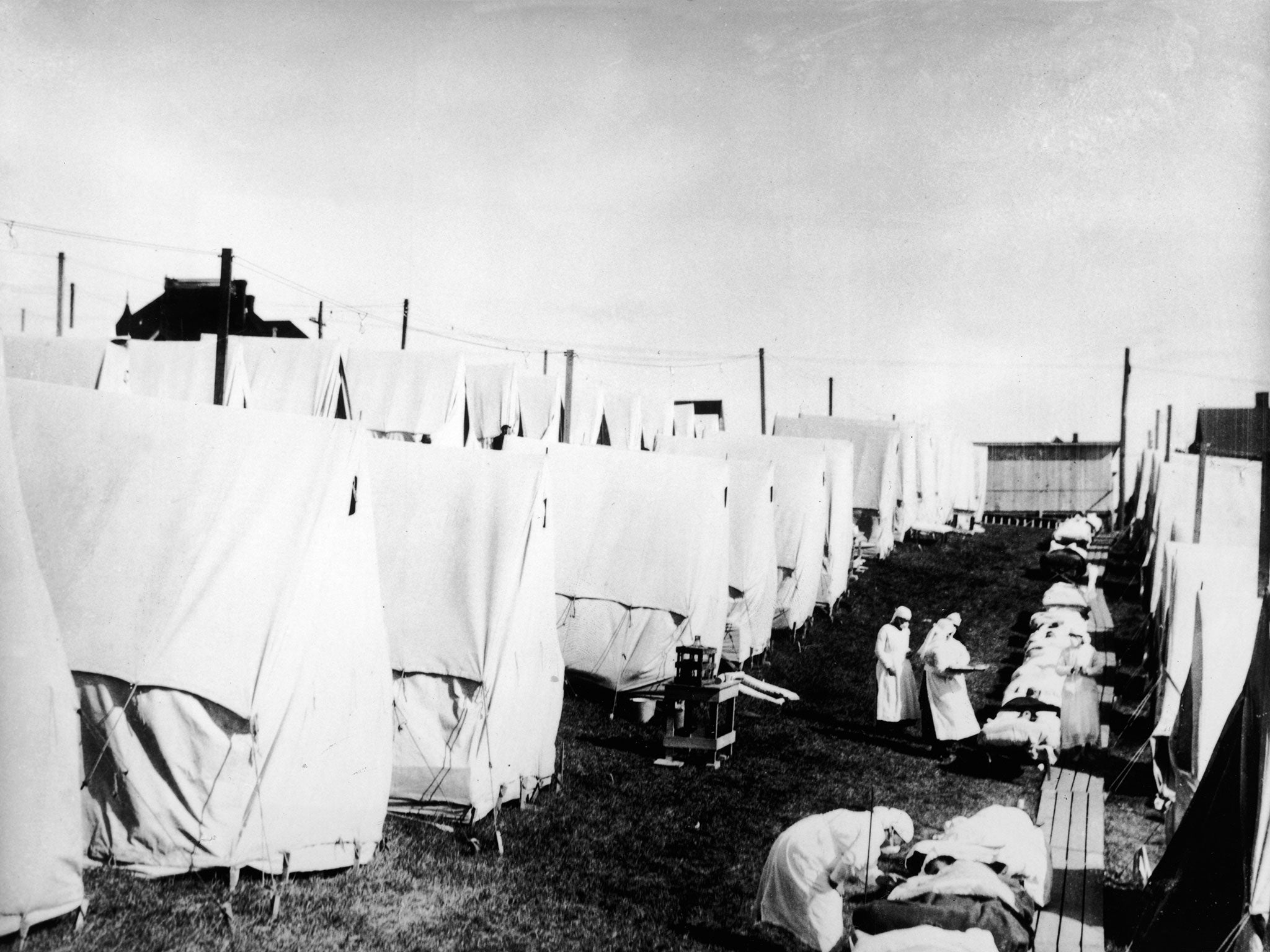A History of the First World War in 100 Moments: First sniffles of a catastrophe that would claim millions of lives
As the conflict entered its final few months, a new horror was unleashed on humanity: a deadly pandemic that would ultimately kill more people than the war itself

On Monday, 11 March 1918, Albert Gitchell, a cook at Fort Riley in Kansas, a military training camp, reported to the hospital with a “bad cold”. He was feverish, and complained of a sore throat, headache and muscular pains. By noon that day, 107 patients had been admitted with similar symptoms. Within five weeks, 1,127 men out of 26,000 in the camp, were infected.
As the Great War was ending, a threat emerged that was even more lethal than the fighting that had brutally cut down so many young men. The influenza pandemic of 1918-19 claimed the lives of between 20 and 40 million people around the world, substantially more than the estimated 18 million (10 million combatants and eight million civilians) killed in the war itself. More died in a single year than were killed in the four years of the Black Death from 1347-51.
The death rate was relatively low in the first US outbreak but the second wave which started in Boston in the early autumn was much more severe. The virus appeared to have mutated over the summer. Philadelphia, hardest-hit of all US cities, was struck in October with 700 deaths in the first week, 2,600 by the second week and 12,162 by 2 November. Churches and schools were closed, but the newspapers continued to devote their front pages to news from the battle front in Europe.
The disease emerged in pockets across the globe and at first, as it did in Fort Riley, seemed as benign as the common cold. Soldiers in the trenches in France became ill with what was known as la grippe – sore throat, headache and loss of appetite. The illness was highly infectious and spread rapidly in the primitive, crowded conditions, but recovery was swift and doctors at first called it “three-day fever”.
The label did not last. This was no ordinary flu. Glasgow was the first British city to be affected, in May 1918, and within weeks the illness had spread south, reaching London by June. During the next few months, 228,000 people died in Britain. The cause of death was usually pneumonia or septicaemia, affecting a fifth of those infected. Unlike ordinary seasonal flu, which was worst in the elderly, weak and sick, the new illness disproportionately struck those aged 20 to 30. Those hale and hearty at breakfast could be dead by tea-time.
London, like other British cities, was ill-equipped to cope with the epidemic. The war had cost the country most of its fortune, industry was disrupted, there was damage to public services and millions were dead, missing or wounded. And ships were bringing soldiers back from the front carrying the virus to their homes and communities.
Hospitals were overwhelmed, and doctors and nurses worked to breaking point, although there was little they could do. Medical schools closed their third- and fourth-year classes and students helped in the wards. There were no treatments against the flu and no antibiotics to treat complications such as pneumonia.
In many towns, theatres, dance halls, churches and other public gathering places were shut, some for months. Streets were sprayed with chemicals and people wore anti-germ masks. Some factories relaxed no-smoking rules, believing that cigarettes would help prevent infection.
On 3 November 1918, the News of the World suggested ways to combat the epidemic which are relevant today: “Wash inside nose... each night and morning; force yourself to sneeze night and morning, then breathe deeply. Do not wear a muffler; take sharp walks regularly and walk home from work; eat plenty of porridge.”
Armistice Day on 11 November, marking the end of the war, set off a second wave of infection. As people gathered to celebrate, the virus swept through them. Parties and parades turned to disaster.
Katherine Garvin, daughter of James Garvin, editor of The Observer during the First World War, described going to London to join the Armistice Day celebrations with her mother, Cristina.
“I remember her crying through all the rejoicing and saying, ‘It is too late for me.’ Nearly [two] months later she died in her sleep after a bad attack of influenza that had overrun England after the war. She was a war casualty. The doctor had been in the morning and said she was better. But at some time in the afternoon of Christmas Eve, the eve of her 43rd birthday, her heart gave up and she went.”
The pandemic circled the globe. As the illness swept Europe, Spain was hardest hit, with an estimated eight million dead which led the BMJ to label the disease “Spanish flu”, though it is thought to have originated in China.
No country was spared, except Australia which imposed strict quarantine rules. Entire Alaskan villages were overcome and Western Samoa, a small Pacific island, lost 20 per cent of its population. Worst hit was India, where an estimated 12 million died. By the end, a fifth of the world’s population had fallen sick. No one escaped its effects.
Tomorrow: Attack on Paris
The '100 Moments' already published can be seen at: independent.co.uk/greatwar
Join our commenting forum
Join thought-provoking conversations, follow other Independent readers and see their replies
Comments